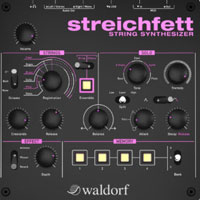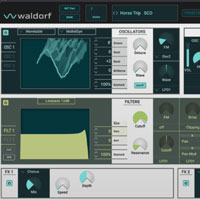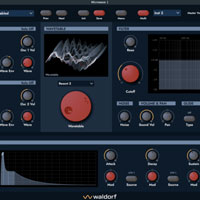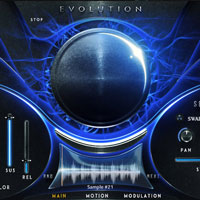Waldorf Largo 1.5.0
Tags: Club basses, Club sounds, Club leads, Synthesizer, Synth strings, Synth pads, Synth bass, Drum and Bass |  |
Waldorf Largo VSTi v1.5.0
New Sounds
Largo V1.5 comes with almost 500 new sounds. Together with the sounds shipping with earlier versions of Largo, this sums up to a total of more than 700 sounds (we have counted 733 so far). A lot of these new sounds take use of the new features of Largo. So, take a day off and carefully listen to the great library we ship with this update.
Browse
The most prominent feature of Largo V1.5 is its powerful Browse page. It is divided in two parts. On the left is a File Browser showing the files and folders of your sound libraries on your hard disk, on the right is a table showing the content of the currently loaded bank.
You can drag and drop sounds between the File Browser and the Program Manager for loading and saving, rearrange sounds on disk or in the current bank, copy and paste, and much more.
You can also drag and drop sounds from the file manager of your operating system (Windows Explorer or Macintosh Finder), or copy and paste selected sounds as a plain text list to a text editor for administrative work.
Search for sounds in the File Browser or Program Manager by typing in part of the name or category and let Largo find the stuff for you. In the File Browser, the search result is presented as a list while in the Program Manager the matching sound are highlighted and the non-matching ones are darkened.
Oscillator Section
By popular demand, we have added three additional parameters per Oscillator to allow finer control over their behaviour:
Startphase controls, as the name suggests, the phase with which the Oscillator starts. Set it to around 90° for a sharp attack, set all Oscillators to the same value to have them start in sync, or let the Oscillators run freely as they do in real analog synthesizers.
Brilliance controls different aspects depending on the Oscillator model used. On the Pulse and the Sawtooth waveform, it controls the mix of the discharge impulse of the capacitor, effectively resulting in a waveform with stronger high harmonics. With Wavetables, it controls their interpolation smoothness from perfect interpolation to steps. Those steps create additional harmonics especially in the lower keyboard ranges as they happened in the good old PPG Wave and the Waldorf Microwave and Wave.
Last but not least, the Limit parameter controls if the "analog" waveforms found at the end of most Wavetables are included into Wave Modulations or if they are left out. This helps creating wavetable scans without always keeping an eye of not hitting those accidentally.
Arpeggiator
The Arpeggiator now has the same power as the one found in Largos famous ancestors, the Waldorf Q, Micro Q and Blofeld. It offers various step types per step including fancy ones like Chord and Random. This means that you are not limited to either have an arpeggio or a chord repeater, you can have both depending on the step the arpeggiator is currently playing. And it now offers a separate Glide per step for your classic Bassline simulations.
Just look at the picture and you see that this pattern plays eight steps with different accents and lengths, and that in the bottommost row you see different symbols. Filled circles denote normally played steps, downward arrows tell the Arpeggiator to play the first note in its list, and the two-note-symbol results in a chord consisting of all currently held notes.
Chorus and other effects
Largos new Chorus comes in three flavours. The one with two stages you already know from earlier versions, and now also with four and six stages to create lush pads and strings. Spread controls the behaviour of the four additional stages, when set to zero, all six stages run in sync with a fix offset creating the ensemble effect of old string machines. When set higher, the modulation is increasingly decorrelated to make the Chorus thicker and wider. But we didn't stop here. We've also added Feedback to make the Chorus effect even thicker. And together with the quite long delay time, you can now abuse the Chorus as an additional Comb filter (as if the Largo hadn't enough of them already).
We are not stopping here. Also by popular demand, we added the selection of Delay and Reverb to the first effect slot. So, you can now create sounds with a Delay and Reverb at once. Or use two Reverbs, one set to a small room and the other to a large hall.
What else is new?
Besides fixing a number of bugs we have now tested Largo with the FXpansion VST2RTAS Wrapper in ProTools, added text input for almost all controls by double-clicking them, added scroll-wheel support for almost all controls, implemented system-wide copy and paste (not only between different Largo instances but even to other applications like a text editor) and, last but really not least, provide clock menus for all parameters that can be set to sync to incoming clock information. This menu contains the most often used entries so you can get your 16th Arpeggiator or dotted-8th Delay really quick.
General Features
- Powerful File Browser
- Program Manager for easy reorganization of bank content.
- up to 256 voices per instance (depending on available CPU power)
- up to 4 layers per sound
- 4 stereo outputs (alternatively 1 stereo sum)
- host automation of almost all parameters
- MIDI Controller automation of the most important parameters
Per Voice
- 5 Oscillators
- 3 Main Oscillators
- 2 Sub Oscillators
- Virtual Analog Models:
- Pulse with Pulse Width Modulation
- Sawtooth
- Triangle
- Sine
- Wavetables:
- 68 wavetables taken from the legendary Microwave and Wave synthesizer as also Q and Blofeld wavetables
- Frequency Modulation between Oscillators and Noise Generator
- Oscillator Synchronization
- Variable Startphase per Oscillator
- Brilliance for Pulse, Sawtooth and all Wavetables
- Ring Modulator for Osc 1 / 2
- Noise Generator with Noise Colour
- 2 independent Multi Mode Filters
- Filter FM
- Resonance up to Self-Oscillation
- Low Pass 24 dB / 12 dB
- Band Pass 24 dB / 12 dB
- High Pass 24 dB / 12 dB
- Notch 24 dB / 12 dB
- Comb Filter with positive / negative Feedback
- 2 Drive Stages per voice with adjustable Drive Gain and selectable Curves
- Clip
- Hard
- Medium
- Soft
- Sine Shaper
and more
- Modulation Matrix with 16 Slots, freely programmable
- Modulation Speed far into Audio Range
- Modulation Sources include all internal Modulation Sources plus various MIDI messages
- Modulation Destinations for almost all continuous sound parameters
- various pre-routed Modulation Destinations with selectable Sources
- Pitch Modulation
- Oscillator 1 / 2 / 3 Frequency Modulation
- Oscillator 1 / 2 / 3 Pulse Width Modulation
- Filter 1 / 2 Cutoff Modulation
- Filter 1 / 2 Frequency Modulation
- Pan 1 / 2 Modulation
- Amp Modulation
- 4 Modifiers for transforming Modulation Sources with various Algorithms
- 3 fast LFOs
- syncable to MIDI Clock
- Note Retrigger with adjustable Start Phase
- monophonic LFO
- Keytrack
- freely drawable LFO waveform with 16 steps (only LFO3)
- 4 fast Envelopes with selectable types
- Single Trigger / Retrigger per Envelope
- ADSR
- ADS1DS2R (2 Decay/Sustain stages plus adjustable Attack Level)
- One Shot
- Loop S1S2 (Loop between Sustain 1 and 2)
- Loop All (Loop over all stages)
- Poly, Mono, Dual or Unisono Mode with selectable Voice Count, Unisono Detune and Stereo Spread
Per Layer
- powerful Arpeggiator
- Hold and One Shot modes
- syncable to MIDI Clock
- Direction Up, Down, Alternate
- Range up to 10 Octaves
- various methods to modify Note Sort Order
- freely programmable Arpeggiator Pattern with up to 16 Steps
- programmable per Step:
- Accent
- Timing
- Length
- Glide
- Pause
- Chord
- Previous Note
- Random Note
- First and/or last Note from list
- 2 Effect slots per layer
- Effect Types:
- 6-stage Chorus
- Flanger
- Phaser
- Overdrive
- Modulation Delay
- Reverb
System Requirements
Windows
- Windows XP or better
- Intel Pentium 3, 1 GHz or better
- AMD Athlon, 800 MHz or better
- 64 MB free RAM
- VST 2.4 compatible host software that supports virtual instruments, such as Cubase VST or higher, Cubase SX/SL, Nuendo 1.5 or better
- PC equipped according to the specifications of the VST host software
Macintosh
- Mac OS X 10.3.9 or better
- PowerPC: G4, 800 MHz or better
- Intel: any processor
- 64 MB free RAM
- VST 2.4 compatible host application that supports virtual instruments, such as Cubase SX/SL, Nuendo 1.5 or better
or - AudioUnit 2.0 compatible host application that supports AudioUnit Instruments, such as Apple Logic or GarageBand
- Macintosh equipped according to the specifications of the host software
You may buy Waldorf Largo 1.5.0 or download it from our website.
This product was released on 07 May 2010. Please check compatibility with your hardware and O/S.
Reviews
Write a Review
From: Your Review: Rating: |
![Waldorf Attack [Full Version] Waldorf Attack [Full Version]](/images/waldorf_attack.jpg)








![KORG Legacy Collection [MAC] KORG Legacy Collection [MAC]](/images/Legacy.jpg)
